Nature Conservation 2024 — 30. 5. 2024 — International Nature Conservation — Print article in pdf
A Hope from Gabon. Protected Areas, Ecosystem Services, and Economic Diversification
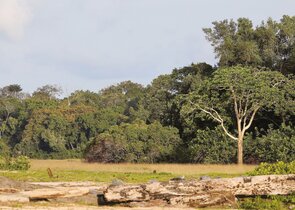
The country in a nutshell
By African standards, Gabon located on the Equator in the Gulf of Guinea is a small country (267,670 km2); on the equator in the Gulf of Guinea (3.5 times the Czech Republic’s territory), it has only around 2.2 million inhabitants. In The capital, Libreville, less than a million people lives, and the total proportion of the urban population is close to 90%. The number of inhabitants is growing by 2.5% annually, female fertility is approx. 4. Roughly, 80% of the country’s territory is covered by primary or secondary rainforest and a smaller part by savannah. Only approx. 1.2% is used as arable land: at the same time, the rainforest coverage has been practically stable (only a 1% decrease in 10 years).
According to the World Bank, GDP/per capita is about USD 10,000 while in the neighbouring People’s Democratic Republic of Congo, it is USD 600). Only a small part has a hilly character (the highest ridges exceed 1,000 m a.s.l.); the coast forms the western border with a length of about 900 km. Gabon not only has well-preserved preserved natural environment but is also among the safest African countries.

Protected areas in the vicinity of the capital, Libreville. © Jan Vrba
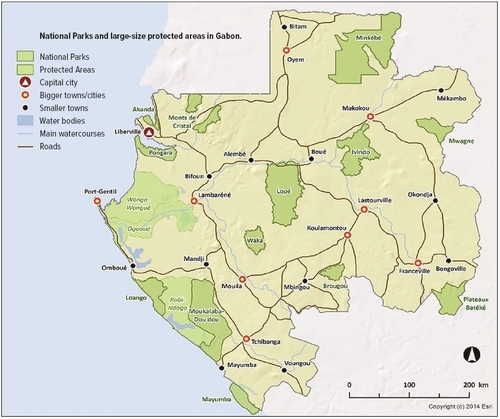
National Parks and large-size protected areas in Gabon. © Jan Vrba
A few facts about the economy
The country has large reserves of mineral resources, especially oil, manganese, iron ore, uranium, gold, lithium, tungsten, tin, and coltan, from which tantalum and niobium are obtained (irreplaceable metals for the development of the modern electronic industry). Since the early 1990s, Gabon has been one of the richest and most developed economies in sub-Saharan Africa, mainly thanks to oil extraction. It has the status of an upper-middle income country but is highly dependent (over 60%) on agricultural and food imports, which was exposed during the COVID-19 pandemic, when borders were closed and prices of many foods increased by 100%. Therefore, the the increase in prices of basic foods was kept under control by special government subsidies.
Economic policy is guided by a plan to diversify the economy, develop infrastructure, support agriculture, production, services and tourism (“Gabon émergent”), which aims to bring Gabon into the category of “new” economies and reduce the country’s one-sided dependence on oil, mineral, and timber extraction. The government is trying to attract foreign investors to the country, developing special economic zones and focusing on the export of goods with higher added value (by building wood processing plants, oil refineries, etc.). The proportion of Gabonese industry in GDP is about 61%, annual growth being approx. 4%. Sugar, flour, cigarettes, soft drinks, beer, and bread are locally produced and in small establishments. The national parks have great potential for the development of ecotourism, which is one of the fields that intend to contribute to the diversification of the economy (e.g. ALU 2020).
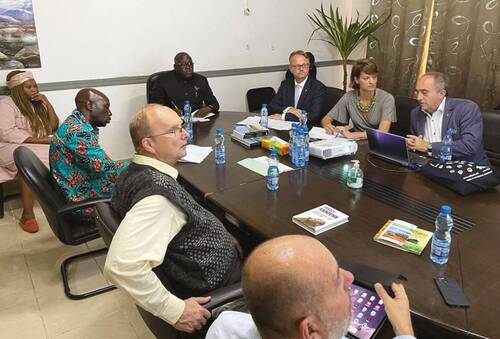
A meeting at the National Agency for National Parks of Gabon. ANPN Director Christian Tchemambela is at the head of the table. © Nature Conservation Agency of the Czech Republic Archive.
Political stability: past, present, and future
By African standards, Gabon is economically fairly sound and, despite its vulnerability, a relatively stable country. It was part of the French colonies until 1960. Gabon, like most post-colonial countries, has gone through complex development.
A presidential republic form of government is stated under the 1961 constitution; in 1991, two-chamber parliament was established, with several political parties. The president is elected directly by a simple majority. The last election in 2016 was marred by confusion surrounding the conduct of the election, with an opposition candidate refusing to recognize its results. Presidential elections were set for 2023. To summarise imprecisely, it is an enlightened autocratic government with elements of democracy.
Gabon’s position in international politics is interesting. It is certainly among the most active players in the field of climate change and biodiversity protection and conservation, and, economic policy, it shows a rational pragmatic approach. For example, China’s influence in the country is taken with reservation because the government is aware of the specific approach of this neo-colonial power, which collects economic benefits, including employment, disproportionately only for its own benefit. According to some information, quite a few Asian mining and other companies have gradually been replaced by American and European entities. Gabon, like a large number of other African countries, abstained from condemning the Russian invasion of Ukraine at the United Nations. For many African countries, including Gabon, the Russian invasion is interpreted as a European problem with an unclear background. Particularly in former colonies, such an approach is quite surprising.
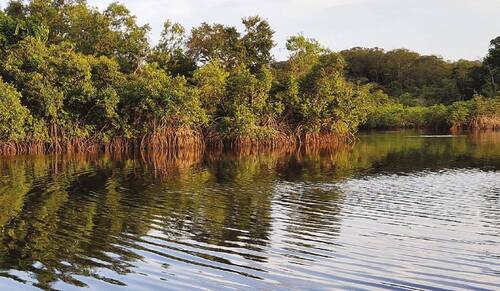
The coast of Gabon has numerous and often extensive mangrove growths. Pongara National Park © František Pelc
Well-developed nature conservation
The country also has a National Parks (NP) network, which, by African standards, is well managed by the National Agency for National Parks (ANPN – Agence Nationale des Parcs Nationaux du Gabon), having approx. 800 employees. The ANON manages all 13 declared NPs and some other protected areas covering an area of more than 11% of the country (about 30,000 km2). However, the total extent of Protected Areas, including declared Wetlands of International Importance (Ramsar Sites), is 22% (ALU 2020). However, the absolute key for Protected Areas in Gabon is the systematic and long-term support from President Ali Bongo Ondimba (his father Omar Bongo Ondimba started the process of establishing the parks). This is directly related to the support from the government, where the Minister of Water, Forests, the Sea and Environment is the Gabonese-British scientist Lee White. This small country is now home to 2/3 of the African forest elephant (Loxodonta cyclotis) population and 2/3 of the Western lowland gorilla (Gorilla g. gorilla) population. All this is thanks to well-functioning nature conservation and a low population density (8 inhabitants/km2 on average).

Ecotourism has great potential for both nature conservation and economic prosperity in Gabon. So far, it has only been developed in a few places. Pongara National Park © František Pelc
Rainforests, biodiversity, and ecosystem services, including carbon sequestration
The rainforests of the Congo River Basin have a huge CO2 absorption capacity for several reasons (carbon sequestration is estimated at 140 million tons per year for Gabon alone). Gabon seeks to make this ecosystem service the subject of international payments, which would contribute to the protection of this globally unique biome, the limitation of negative climate change and, simultaneously, to the region’s economic prosperity. However, its efforts have only been partially successful. At the 2022 United Nations Climate Change Conference in Sharm el-Sheikh, Egypt, Gabon tried to push this along with other African countries. Unsuccessfully. We believe that Gabon is well prepared, unlike most other developing countries, to discuss this rational issue. It is interesting that carbon sequestration is several times higher in the Congo River Basin forests than in the Amazon forests. The reasons are to be found in the different ecological conditions and forest structure.
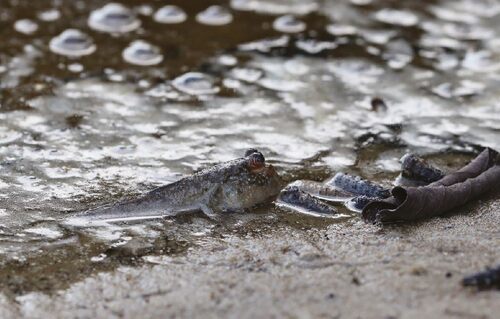
The Atlantic mudskipper (Periophthalmus barbarus) is an example of the little-explored biodiversity. Pongara National Park © František Pelc

The Grey pratincole (Glareola cinerea) is a common bird of sandy muds along rivers and coasts. Pongara National Park © František Pelc
National parks and other protected areas
Establishing National Parks and other protected areas is connected with the expedition of the American ecologist Mike Fay in the Congo River Basin at the turn of the millennium. In 15 months, he walked over 2,000 km through the jungle and got to know a significant part of the Gabonese rainforest with the help of a light aircraft. He selected the first eleven areas where he recommended establishing National Parks. He approached the then Minister of Forestry with his plan. The latter had a certain degree of understanding of the plan, but in the first stage only he accepted the declaration of one national park, partly overlapping with the Lopé Reserve. The reason was, inter alia, existing (purchased) concessions from companies for logging forests, usually of French origin, which needed to be resolved. The two men introduced the plan to the then President, Omar Bongo, who liked the plan for better nature conservation, but it was incomprehensible to him that someone had walked endless hundreds of kilometres through impenetrable forests. He himself admitted that he drove everywhere and usually walked only a few hundred metres from the road. He understood that logging was only a temporary income for the country. He appreciated the project, but to the surprise of everyone present, he wanted to implement it as a whole, and not gradually over many years. After the meeting, he ordered the Minister to resolve the contracted mining concessions within a year.
As early as 2002, at the United Nations World Summit on Sustainable Development in Johannesburg, President Bongo announced that Gabon had established a network of 11 new National Parks with a total area of 10% of the country’s territory as a contribution to biodiversity protection and a long-term economic alternative to logging. The then United States Secretary of State, Colin Powell, also announced there that the United States had contributed more than USD 36 million to the implementation of the programme.
Since then, the Protected Area network in Gabon and their viability has systematically improved and is one of the best in Africa; e.g. a strategy of ecologically friendly forest management was developed that should reflect biodiversity and not reduce the forest coverage belonging to the State, which is a totally exceptional phenomenon. Solid background information can be found in a publication issued by the ANPN (Jouve & Jouve 2012). National Parks with the most developed ecotourism and truly unique species and ecosystem diversity are Loango (Fay 2004, Van de Veghe 2013) and Lopé (Bhattacharjee 2022).
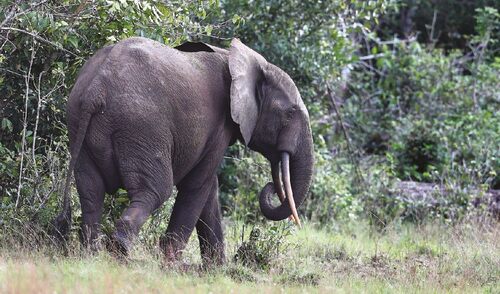
The African forest elephant (Loxodonta cyclotis) is successfully protected in Gabon and its population is estimated at more than 90,000 individuals (2/3 of the entire population). The species is about the size of the Indian elephant (Elephas maximus), about 1/3 smaller than the African bush elephant (L. africana). In addition to forest destruction, it is threatened by poaching for ivory, which is said to be of better quality than that of related species. Pongara National Park © František Pelc

The African forest buffalo’s (Syncerus caffer nanus) weight is about half that of the African Cape buffalo (Syncerus c. caffer), has a different colour, and likes wetlands. Pongara National Park © František pelc
Suburban protected areas are far from parks
Only a few kilometres from the capital, three protected nature areas have been declared. Although they are among the smallest in Gabon, they are not suburban parks, as it might seem. For example, to the south of the city across the bay, the Pongara National Park can be reached by boat in a few dozen minutes; it is almost as large as the combined area of the Šumava/Bohemian Forest Mts. and Krkonoše/Giant Mts. National Parks in the Czech Republic. In the National Park, covered with rainforest, savannah and mangroves, you can find African forest elephants, African forest buffalos (Syncerus caffer nanus), and non-habituated western lowland gorillas; green sea turtles (Chelonia mydas) nest there. North of the capital on the coast, the Akanda National Park is easily accessible, a third larger than the Krkonoše/Giant Mts. NP. It is a famous wintering place for Eurasian water birds.
Protected areas in the vicinity of the capital Libreville
The most accessible nature reserve is the Mondah Forest Reserve, which basically starts in the north-western suburbs of Libreville. In the course of the development of urbanization and forest logging, its protection and the delimitation of the boundaries were changed (Walters et al. 2016). At the time of its declaration, in 1951, it covered an area of 102 km2, but it gradually decreased to a minimum of 49 km2 in 2004. In recent years, the reserve has been transformed into a forest arboretum of the original primary forest; in 2012, its area increased to 67 km2, when new, not yet felled parts of the ecosystem connecting the reserve with the Akanda National Park were added. This suburban reserve is comparable in size to the Podyjí/Thaya River Basin National Park. It serves not only for nature conservation but also for education of local people and for relaxation. There are several dozens of kilometres of trails. Incidentally, President Emmanuel Macron visited the site at the beginning of 2023 as part of his African political tour.
Possibilities for cooperation
In October 2022, a Czech delegation met representatives of the Gabonese government (the Ministry of the Environment, the Ministry of Mining, and the National Agency for National Parks). The question was in which environmental areas was there a possibility of cooperation between Gabon and the Czech Republic.
Gabon has solid nature conservation and is trying to improve its knowledge of its extraordinarily rich and still underexplored biodiversity. The Nature Conservation Agency of the Czech Republic (NCA CR) presented a simplified version of the information system for gathering, analysing and distributing the data on the selected umbrella species. Species that are important from the ecological and conservational point of view could be monitored, with exact occurrence recorded in a smartphone application, even at sites beyond the reach of the Internet. Subsequently, the data would be sent to the central species database for further use. It seems appropriate to run a pilot project for one or two Gabonese National Parks and, after testing, expand the plan. Therefore, the NCA CR would be the main partner for the Czech side.
Gabon will remain dependent on the extraction of minerals for a long time to come. However, according to the government, their extraction must be environmentally friendly. Therefore, the greening of mining technologies, the well-thought-out organization of mining, and the subsequent restoration of areas affected by mining towards semi-natural ecosystems or rich in biodiversity appear to be another area of possible cooperation. There, the main guarantor for the Czech side could be the Institute of Geology, the Academy of Sciences of the Czech Republic Prague in cooperation with the NCA CR.
The development of ecotourism, including ecotourism facilities, is an important part of the diversification and development of the Gabonese economy, and ultimately one of the key prerequisites for the effective and sustainable protection of natural ecosystems and biodiversity. The Gabonese Ministry of the Environment has proposed some strategic but rather general plans. The NCA CR in cooperation with the Faculty of Environmental Sciences, Czech University of Life Sciences Prague can offer its experience with preparing a feasibility study in Zambia within the framework of Czech Official Development Aid (ODA).
A framework for the exchange of practical experience and lessons learnt between experts from both countries was also agreed.
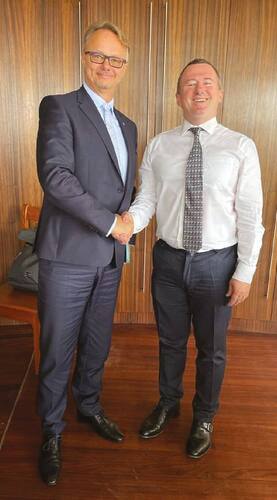
The meeting with the minister was free of formalities and very matter-of-fact. On the left, the Head of the Czech Republic’s delegation, Deputy Minister Tomáš Tesař, and Gabonese Minister of the Environment Lee White. © František Pelc
Conclusion
Gabon is one of the leaders in the protection of the environment and nature conservation, not only in Africa, but also worldwide. Its approach and experience are useful and inspiring not just for developing countries. The authors believe that this approach will be sustainable and systemic in the long term. ■
- - - -
(postscriptum: In 2023, the general and presidential elections in Gabon were anulled following a military-led coup which transferred the powers to the army and led to the dissolution of state institutions. The future of nature protection is therefore uncertain)
- - - -
Cover photo:
More than 80% of the Gabon’s territory is covered by primary or secondary rainforests. Humid savannahs are also present at some sites. Pongara National Park © František Pelc

